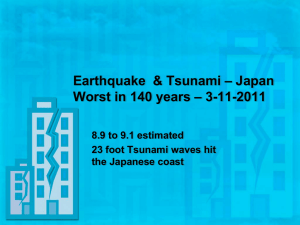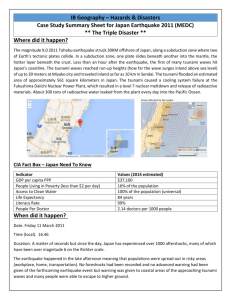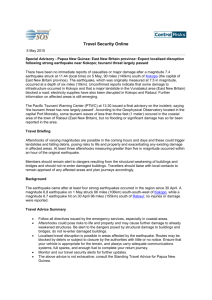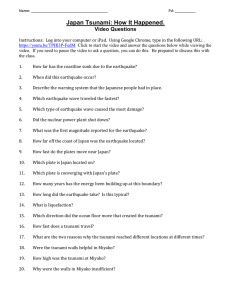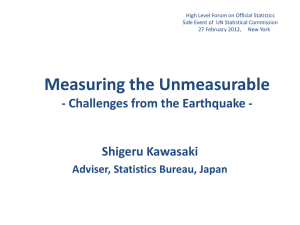Japan 2011 case study
advertisement
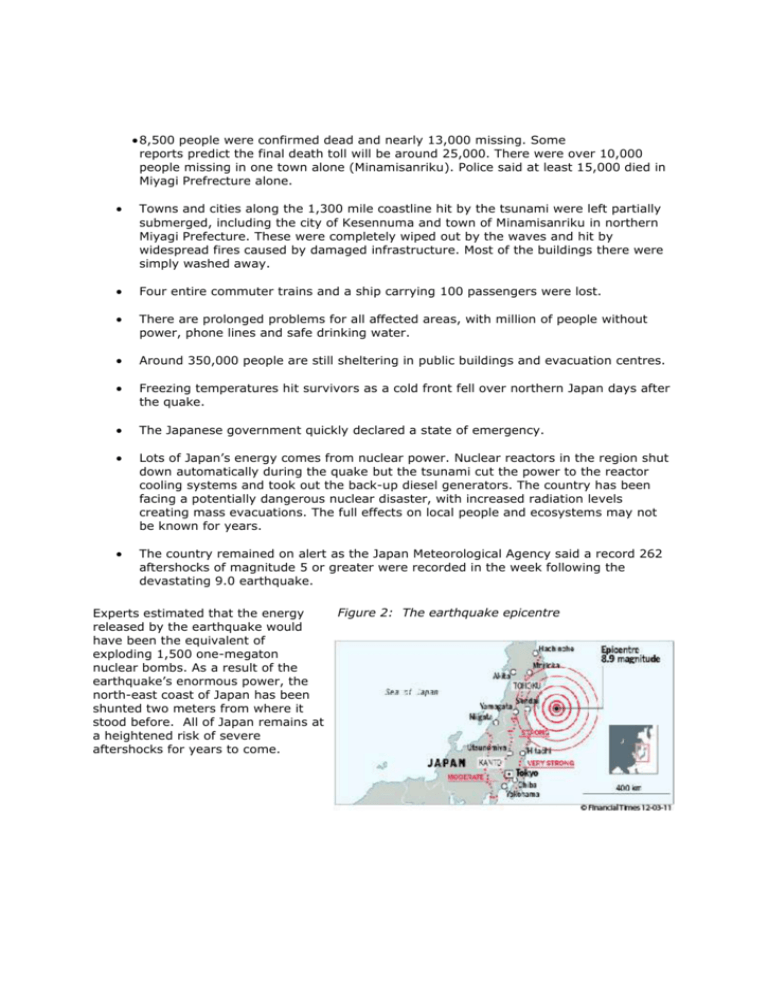
8,500 people were confirmed dead and nearly 13,000 missing. Some reports predict the final death toll will be around 25,000. There were over 10,000 people missing in one town alone (Minamisanriku). Police said at least 15,000 died in Miyagi Prefrecture alone. Towns and cities along the 1,300 mile coastline hit by the tsunami were left partially submerged, including the city of Kesennuma and town of Minamisanriku in northern Miyagi Prefecture. These were completely wiped out by the waves and hit by widespread fires caused by damaged infrastructure. Most of the buildings there were simply washed away. Four entire commuter trains and a ship carrying 100 passengers were lost. There are prolonged problems for all affected areas, with million of people without power, phone lines and safe drinking water. Around 350,000 people are still sheltering in public buildings and evacuation centres. Freezing temperatures hit survivors as a cold front fell over northern Japan days after the quake. The Japanese government quickly declared a state of emergency. Lots of Japan’s energy comes from nuclear power. Nuclear reactors in the region shut down automatically during the quake but the tsunami cut the power to the reactor cooling systems and took out the back-up diesel generators. The country has been facing a potentially dangerous nuclear disaster, with increased radiation levels creating mass evacuations. The full effects on local people and ecosystems may not be known for years. The country remained on alert as the Japan Meteorological Agency said a record 262 aftershocks of magnitude 5 or greater were recorded in the week following the devastating 9.0 earthquake. Experts estimated that the energy released by the earthquake would have been the equivalent of exploding 1,500 one-megaton nuclear bombs. As a result of the earthquake’s enormous power, the north-east coast of Japan has been shunted two meters from where it stood before. All of Japan remains at a heightened risk of severe aftershocks for years to come. Figure 2: The earthquake epicentre Was Japan prepared? Japan has a very high level of preparedness for large earthquakes and tsunami, but not of this scale and magnitude. Good engineering and strict government building codes will have saved tens of thousands from the earthquake in Tokyo and other built-up areas. The earthquake warning system, which has never been triggered before, automatically issued alerts via television and mobile phones shortly after the first, less harmful, shock wave was detected, providing time for many people to prepare for the more powerful shock wave that followed. It also caused many energy and industrial facilities and transportation services to shut down automatically, including the nuclear power stations. A string of detection buoys in the Pacific Ocean detected the tsunami that resulted from the earthquake, sending warnings of possible catastrophe to many different nations. This will undoubtedly have saved many people as it alerted them to move to higher land, but the magnitude and speed of the wave was just too great for many of the more vulnerable. The old and the very young were affected most, not being able to mobilise in time. Lack of such a warning system in the Indian Ocean resulted in the deaths of tens of thousands of people who, despite having time to escape, where left none the wiser that The village of Tarou was tucked behind a 10m tsunami wall. This was built in response to successive tsunami which destroyed the town in 1896 and again in 1933. The 10m wall wasn't high enough for this one. The water topped the wall and ran up destroying most of the houses, and also started fires. Those fast enough made it to higher ground or to the upper floors of reinforced concrete buildings (schools, hospitals, etc.)

